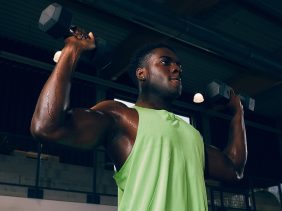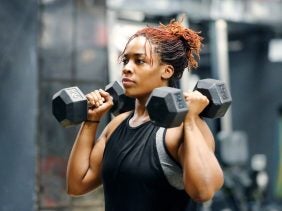Functional Training: These 8 moves are guaranteed to get you burning
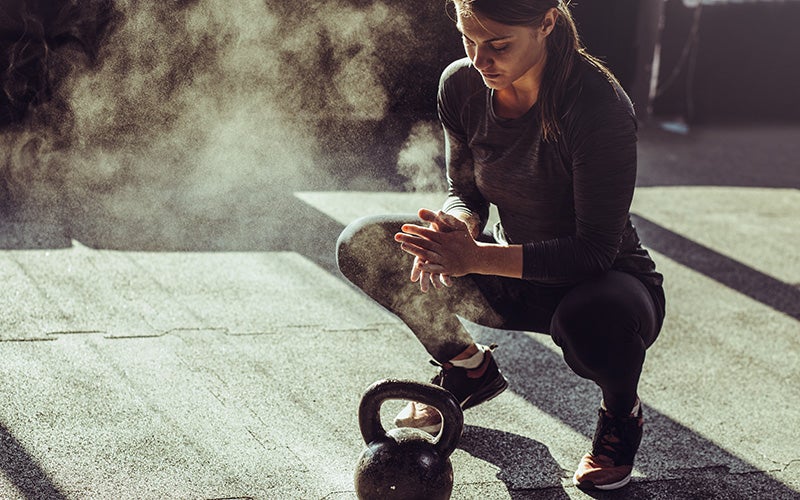 ©Likoper
©Likoper
Though you might have already heard of functional training, you also might not know exactly what it is. In this article, we explain everything you need to know to incorporate it into your fitness routine, including the types of exercises it involves and how often you should train.
What is functional training?
Functional training is a form of training with an intended purpose, like improving quality of movement and preventing injuries. It involves a series of exercises and functional movements in which several muscles interact with each other simultaneously, also known as compound exercises. Improving core stability and coordination are two of the central elements of functional training and the foundation of an injury-free cardio and strength training practice in general.
“Movements that involve only one muscle are considered non-functional. Functional forms of movement systematically integrate several muscles and muscle groups at the same time.”
– Gary Gray, founder of functional training1
Functional training mainly consists of body weight and compound exercises, sometimes with fitness tools, in order to develop inter and intramuscular coordination.
What does “functional” mean?
In the literal sense, the term “functional” means “performing a function.” In the context of exercise, it refers to performing a series of functional movement patterns in order to strengthen and engage the muscles and the central nervous system.
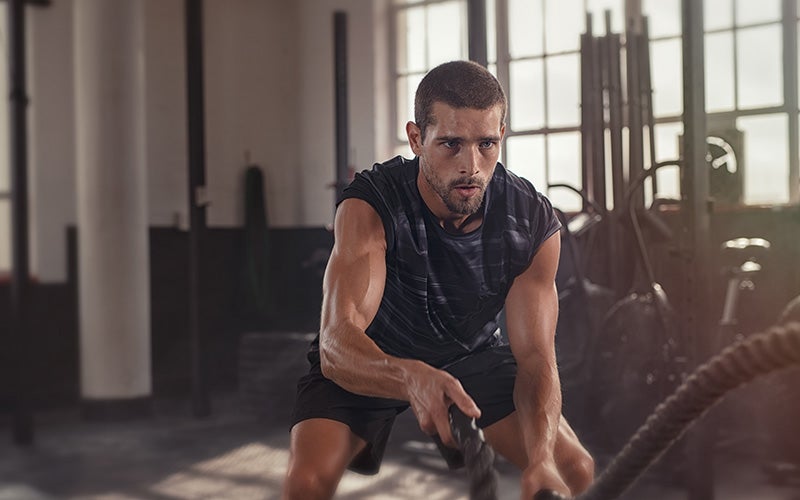
In principle, all human beings, whether they are professional or amateur athletes, have exactly the same needs: a healthy body capable of mastering all the movements it needs to make without problems. In reality, our physiological needs vary from person to person.
Definition of functional training
With this information, we’re able to clearly define what functional fitness is and what it involves2.
Functional training…
- always involves several muscle groups at the same time.
- always includes core training.
- involves multidimensional and multidirectional functional movements that activate all axis levels in the body.
- integrates the 5 fundamental motor skills of fitness: strength, endurance, speed, mobility, and coordination.
- takes into account the athlete’s personal situation.
- includes working with free weights, unstable elements, small accessories, and body weight.
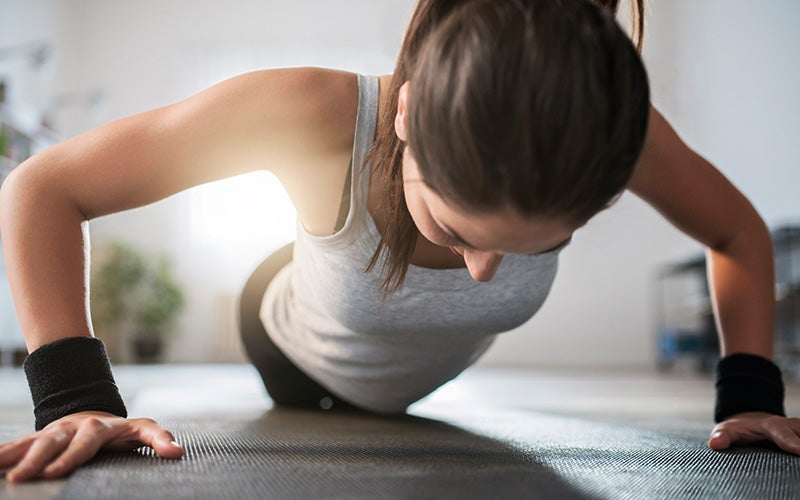
We also need to mention that the term “functional” means different things for different people. For people who are healthy and work out regularly, you can see “functional” to mean what we described above. But there are also plenty of people who don’t fit that category! In case of health or mobility challenges, functional training can be used as a form of rehabilitation. In some cases, it can consist of isolated muscle strengthening enabled only by machines.
Who is functional training for?
Functional fitness can easily be adapted to anyone’s needs. It can be a boon whether you’re a professional athlete or just want it to be easier to do everyday activities. And nowadays, functional training classes are offered at many gyms around the world.
Functional training is for you if you…
- want to improve the quality of your movements and minimize the efforts you need to make.
- want to be able to move easily every day.
- want to increase your physical performance.
- want to avoid developing injuries.
- are looking for an ideal workout to engage your whole body.
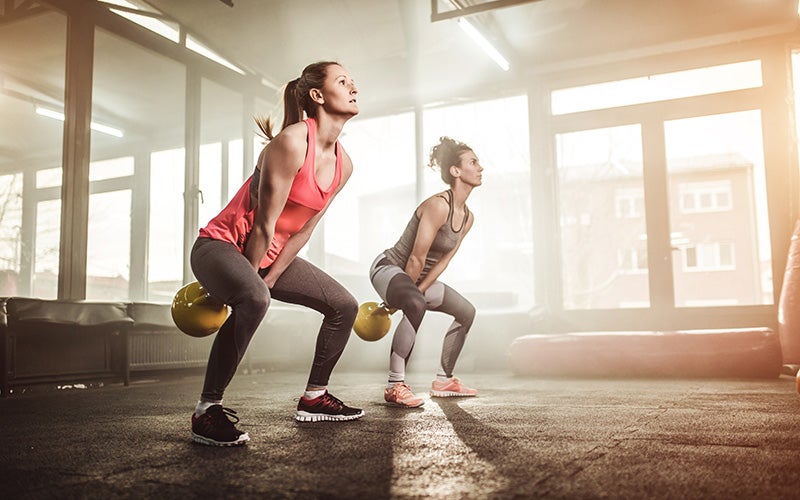
Functional training: Exercise your entire body
Since the goal of functional fitness is to strengthen the core and improve the interaction between different muscle groups, each functional exercise features one or more of the following characteristics.
Functional exercises…
- always involve several muscle groups at the same time.
- often involve the use of unstable elements (small accessories or unstable body positions).
- combine upper and lower body movements.
- engage your full range of motion.
Our tip: The range of motion is a measurement of the amount of movement around a specific point on the body, whether it’s a joint or a limb. In general, you should try to use your full range of motion each time you work out, and adjust as needed to accommodate your abilities or limits.
Let’s take a specific example to show what we mean: squats. Do you avoid going too low because you want to do more reps? Or is it because your heels come up off the floor as your body gets closer to the floor? If it’s the second, hitting that bottom point – with your heels lifting off the floor – might destabilize your knees and actually decrease your mobility or muscle development in the long run.
Functional training means performing the full range of motion. If that means you need to do fewer reps in order to engage the full range of motion, then do fewer. Or if you’d prefer to do the same amount of reps but don’t want your heels to rise, put something (like a book or a weight plate) under your heels to stabilize your knees. Even if it’s a bit uncomfortable at first, you’ll get used to it in no time.
Want to level up your squats? Our deep dive into air squats includes 5 functional squat variations that can bring a quick and effective boost to your technique.
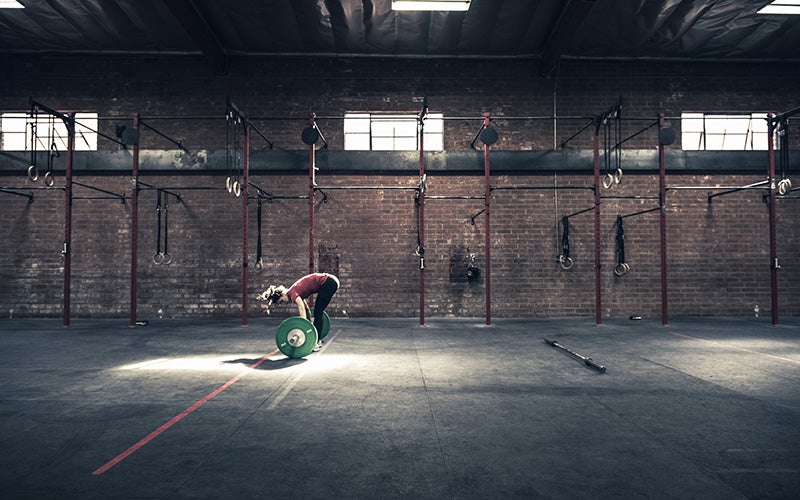
If you’re ready to bring this fitness training into your routine, try out five of our favorite exercises to get started. They’ll improve your mobility, strength, and speed as well as your coordination.
When it comes to improving your endurance, it all depends on how you put together your exercise program. Below, we’ve combined a series of both HIIT (high intensity interval training) and functional training exercises that will give you the best results.
Our tip: Take the time to understand the exercises you’re doing. Try them out step by step before beginning your session, especially if the exercise involves weights. The motto of functional fitness is, “technique is more important than the load you lift!”
Functional Training Exercises: Mobility
Standing Scale to Windmill
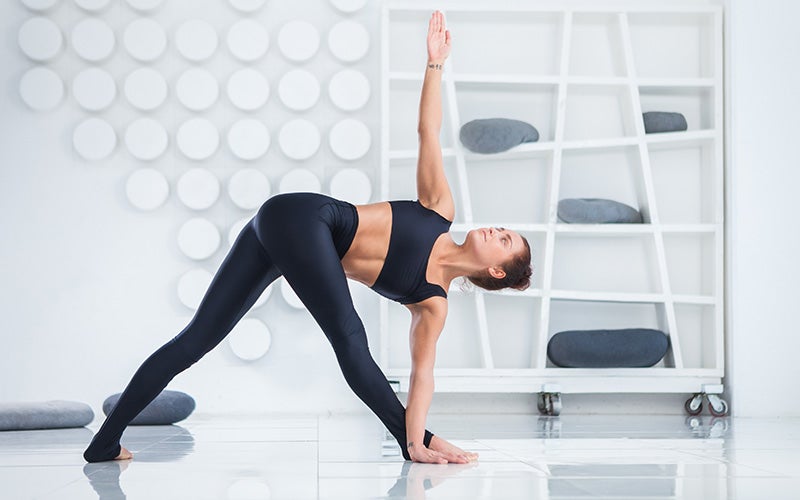
©da-kuk
The benefits
- Activates large muscle groups and deep muscles in the core and back.
- Works intermuscular and intramuscular coordination.
- Improves balance.
Here’s how to do it
- Place feet hip-width apart.
- Perform movements as calmly and slowly as possible.
- Remain in the position and balance for a few seconds.
Variations
- Easier: Stretch your arms backwards.
- Harder: Perform the movement on an unstable surface.
Upward Dog to Hollow Hold

The benefits
- Strengthens the chest and core.
- Activates and engages the mobility of the shoulder blades.
- Stretches and works the mobility of the entire front muscle chain.
Here’s how to do it
- The exercise begins in plank position.
- The top of your feet remain on the ground.
- Begin the movement at chest level: lift your glutes backwards, then lower your hips towards the ground and slowly move your chest forward.
Variations
- Easier: Put your knees on the ground before moving your chest forward. Make sure your knees are as far away from your hands as possible.
- Harder: Lift one foot, then the other, stay a few seconds forward and look over the shoulder in the opposite direction from the foot in the air.
Shoulder Rotation with Mini Resistance Band
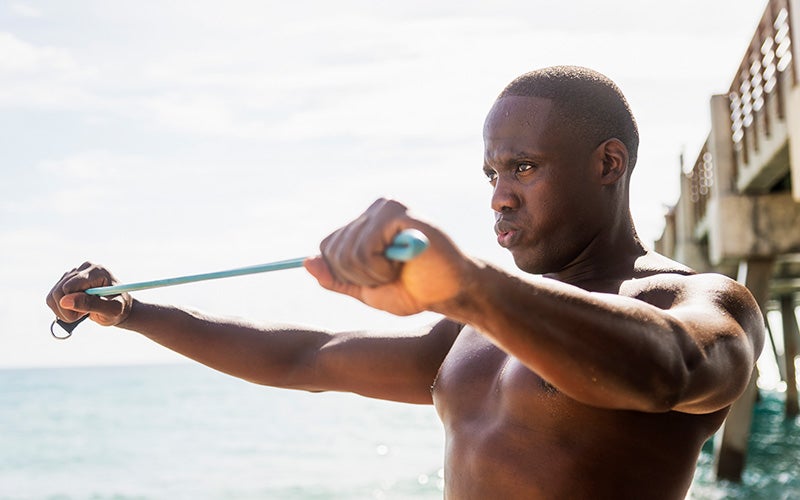
The benefits
- Activates and strengthens the rotator cuff (shoulder muscles).
- Improves control of the shoulder muscles.
- Corrects common imbalances and weak points for people who sit a lot.
Here’s how to do it
- Keep feet hip-width apart, opt for a band with low to medium resistance.
- Put the band around your wrists, palms facing each other, and hands straight out.
- With your arms, make a half circle to the side and slightly downwards, then return to the starting position with a controlled movement.
Variations
- Easier: use a band with a lower resistance or don’t use a band at all and do the movement very slowly.
- Harder: use a band with a higher resistance and, after making a half circle, raise your hands above your head, or even put them slightly behind it, keeping your arms outstretched. Your core shouldn’t move.
Functional strength exercises
Glute Bridge with Slam Ball
The benefits
- Trains the glutes, backs of the legs, abs, and lower back.
- Opens the shoulder blades.
- Reverses the negative effects of sitting too much.
Here’s how to do it
- Keep feet hip-width apart. Ankles and knees should form a straight line.
- Keep knees at the same height throughout the movement.
- Lift your hips as high as possible.
Variations
- Easier: Keep your feet on the ground and press the slam ball between your thighs.
- Harder: Balance your feet on the slam ball instead of the floor.
Push-Ups with Slam Ball
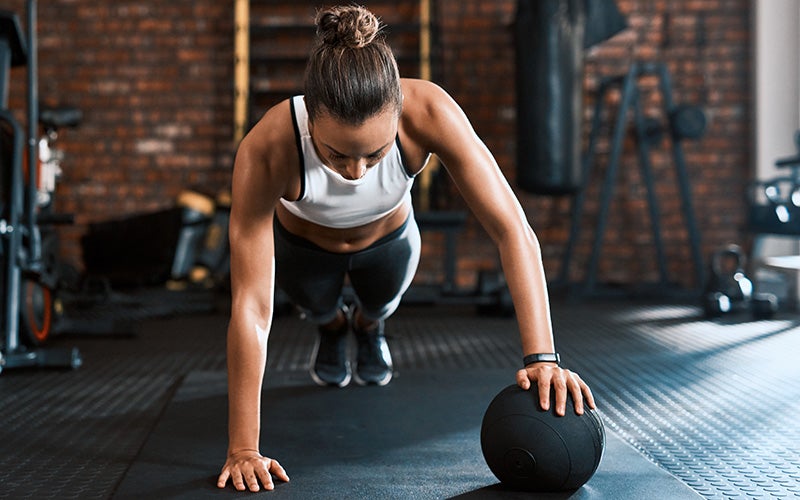
The benefits
- Improves strength and stability of the whole body.
- Strengthens triceps and chest muscles.
- Improves coordination.
Here’s how to do it
- Start in plank position with one hand on the slam ball and do a push up.
- Transfer the slam ball to the other hand while remaining in plank position.
- Find your balance and do another push-up.
Variations
- Easier: Put your knees on the floor, as far away from your hands as possible.
- Harder: Rotate to a side plank, then return to the middle and change sides.
Farmer’s Carry
The benefits
- An easy functional muscle exercise for every day that engages the whole body.
- Improves grip strength and strengthens arms, shoulders, and back muscles.
- Activates the core and leg muscles.
Here’s how to do it
- Start with two weights – dumbbells or kettlebells – of the same weight.
- Set your shoulders low and back, bend your elbows very slightly, look straight ahead, keep your head straight.
- Take small, quick steps, making sure to keep your spine straight.
Variations
- Easier: use lighter weights.
- Harder: use heavier weights.
Side Plank with Rotation
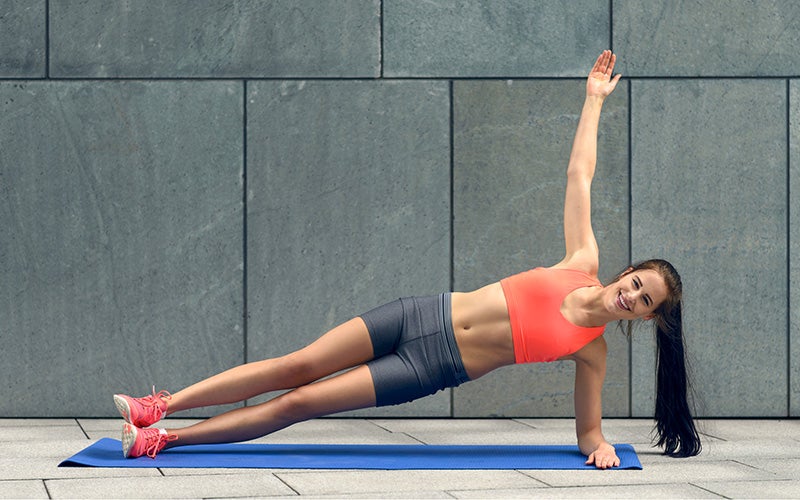
The benefits
- Strengthens the chest and the core.
- Engages the whole body.
- Improves mobility and stability of the shoulder girdle.
Here’s how to do it
- Start in a plank position resting on your forearms. Keep elbows under your shoulders and your body in a straight line.
- Lift your right arm off the ground. Rotate your body to the right and lift your left arm up (if you have a mat, then your left arm should be parallel to the shortest side). Your shoulders and elbows should form a straight line. Extend your right arm up to the sky, raise your hips up to the sky as much as possible. Now bring your right arm under your chest. Only your shoulders should rotate. The rest of your body should remain fixed.
- Make sure that your body does not form an S. It should be a straight line from your ears to your feet, through your shoulders, hips, and knees.
Variations
- Easier: put the knee of your lower leg on the ground or keep your legs straight and put both feet on the ground, one in front of the other.
- Harder: hold a weight in the hand you’re lifting (like a small dumbbell or heavy water bottle).
Overhead Circle, kneeling with slam ball
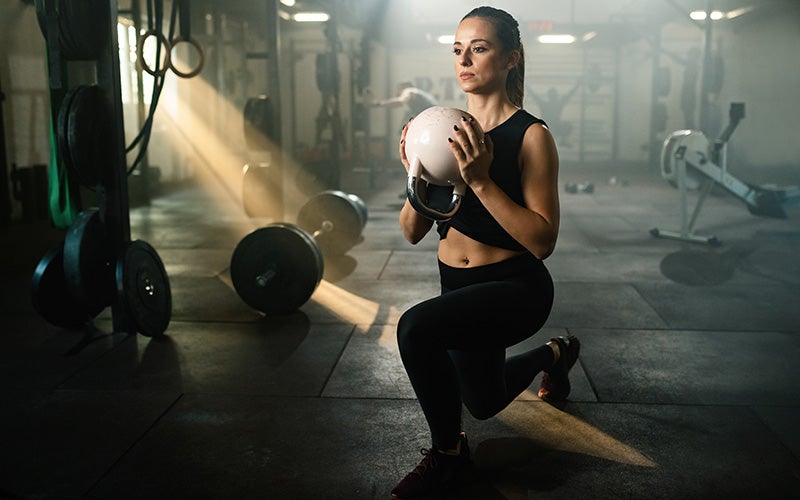
The benefits
- Mobilizes and works the muscles that control your shoulders.
- Improves chest stability.
- Improves intermuscular coordination.
Here’s how to do it
- Begin in a stable lunge position.
- Hold the slam ball in both hands and lift it to your chest.
- Move the slam ball in a circle from left to right, then return to the middle and change direction without pausing.
Variations
- Easier: use a lighter-weight slam ball.
- Harder: use a heavier-weight slam ball.
Functional exercises for speed
Agility ladders
The benefits
- Improves coordination.
- Improves speed.
- Improves ankle mobility.
Here’s how to do it
- Position yourself at one end of the ladder.
- Start by placing one foot in the first square of the ladder, then the other, run in place with both feet, then move to the next square repeating the same sequence, and so on.
- Run as fast as you can, without stepping on the ladder braces.
Variations
- Easier: run as fast as you can to the other end of the ladder with only one foot per square.
- Harder: add steps to the side.
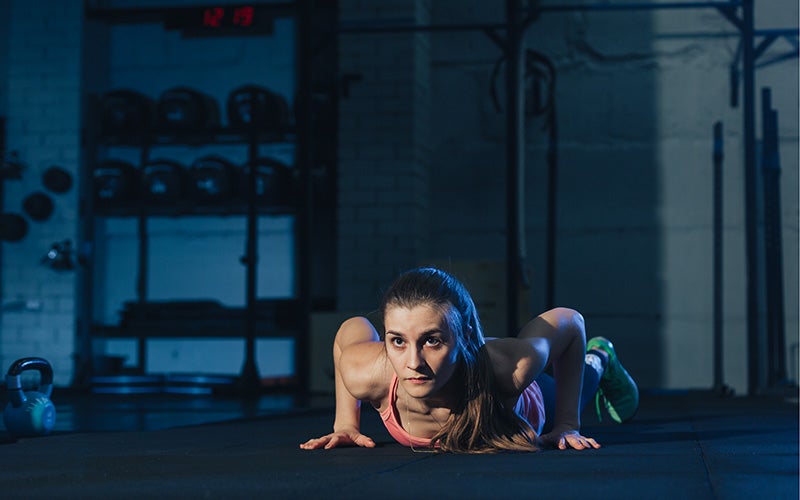
The benefits
- Activates the whole body.
- Engages the cardiovascular system.
- Improves coordination.
Here’s how to do it
- Begin in a standing position. Bend your legs, put your hands on the ground next to your feet, and hop your feet backwards into a plank position.
- Do a push-up, then jump your legs back to line up with your hands, straighten your upper body, use a burst of energy to extend your legs and lead yourself into a jump up into the air as you raise your arms above your head.
- Engage your chest muscles throughout the entire movement, perform the jumps smoothly and land as gently as you can.
Variations
- Easier: instead of jumping your feet backwards, step them back one by one into the plank. Do the push-up with your knees on the ground. Step your feet forward to your hands one by one.
- Harder: Add a tuck jump at the end.
High Knees with Resistance Band

The benefits
- Improves speed and coordination.
- Increases heart rate and boosts fat burning.
- Works abdominal and leg muscles.
Here’s how to do it
- Attach the resistance band to a stationary object.
- Place the band around your hip bone.
- Start running against the resistance of the band. Keep the upper body very slightly bent forward.
Variations
- Easier: use a lower-resistance band.
- Harder: use a higher-resistance band.
Functional Circuit Training
Though circuit training may sound like an Olympic-level challenge, it’s actually one of the most popular workouts because of how it combines functional cardio and functional strength training.
What is the functional circuit training?
Functional circuit training is a workout that combines several functional exercises, done in a specific order. Most of the time, you repeat this set several times. The time you spend on each functional exercise and each rest is pre-set. And regular circuit training is a great way to improve your endurance.
Functional circuit training also means intense exercises and quick transitions between strength and cardio exercises. That’s great for fat burning.
You’ll also benefit from the afterburn effect.
Basic rules
- The quality of the movements takes precedence over the speed of execution.
- Technique takes precedence over the amount of weight you work with.
- Go as hard as you can, but as easy as you need.
How to Do Functional Circuit Training at Home
Let’s go!
Start by jogging in place for 60 seconds. Make circles with your arms in both directions. Repeat each exercise 5 times. For two-sided exercises, perform 5 repetitions on each side.
- Jogging in place while making circles with the arms.
- Standing Scale to Windmill
- Updog to Hollow Hold
- Shoulder Rotation with Mini-Band
Get moving!
Even if you don’t have all the tools, you can still do these exercises with common household items! No slam ball? Take any inflatable ball you have lying around and let out some air until it can’t roll anymore. You can also opt for another unstable surface. For the farmers’ carry, you can use shopping bags or water bottles instead of kettlebells. And for overhead circles, reach for a full water bottle.
- Glute Bridge: 10 reps per side
- Push Up with Slam Ball: 10 reps per side
- Side Plank with Rotation: 40 seconds per side – AMRAP (as many reps as possible for 40 sec)
- Agility Ladder: 40 seconds, as fast as possible
- Overhead Circles: 8 circles in each direction
- Burpees: 40 seconds – AMRAP
- Farmers’ Carry: 40 seconds – AMRAP
- Resistance Band Knee Lifts: 40 seconds – AMRAP
Take a 15-second rest after each exercise. Take a 90-second rest once you’ve finished all 8 exercises.
Beginner: 1 set
Experienced athlete: 3 sets
Advanced athlete: 5 sets
Recovery
A good recovery period is essential to ensuring your muscles and body regenerate properly:
- Active recovery: Jog or walk until your heart rate returns to a normal speed.
- Gentle mobility exercises: Gently stretch all the muscles you used during your workout. If the workout was very intense, avoid stretching directly after your workout.
- Use a foam roller to massage the muscles. Click the link for our 5 favorites.
The 3 basic principles of a functional training program
- How often should I train?
Functional fitness strengthens much more than just the muscles you can see. Your central nervous system also gets a workout. After an intensive effort, it takes up to 72 hours to fully recover. Depending on the level of intensity, you’ll need between 2 to 3 days of rest between each functional training session. At the very least, take one full day of rest per week.
- Diversify the exercises you do.
Varying your exercises and movements is key to successful functional fitness. The more varied your training is, the more muscle fibers you activate and the better your coordination becomes.
- Technique is key.
In functional training, using your full range of motion and correctly executing the moves are also extremely important. If you have any doubts about your technique, take a private class to be 100% sure.
Functional Training and Nutrition
Functional fitness can be high intensity, so you should never start a workout on an empty stomach. Consuming something rich in carbohydrates about 30 to 60 minutes before your workout will give you enough energy to get through a strenuous workout in one piece. Small snacks like our energy bars are perfectly adapted to this purpose.
Don’t have time to eat? No problem: drink our Energy Aminos instead! Full of quality BCAA’s, beta-alanine, and caffeine, they’ll give you all the energy you need.
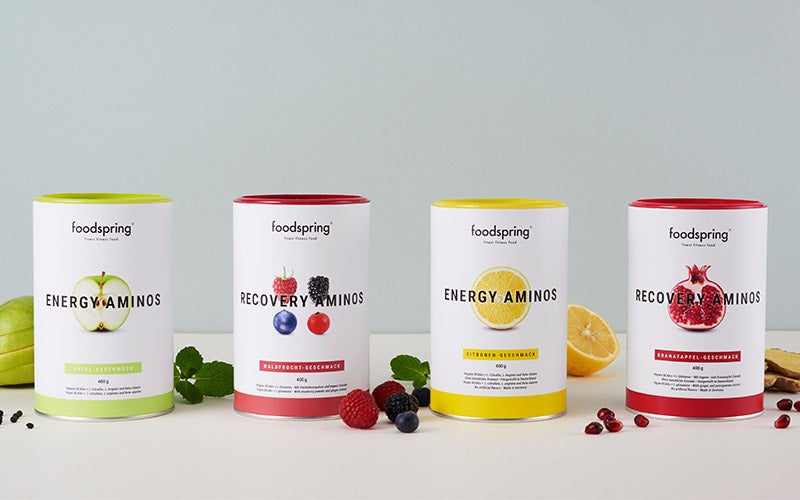
Calories Burned During Functional Training
The number of calories burned during a functional workout depends on, among other things, the intensity of your effort, your fitness level, your weight, your age, your basal metabolic rate and the cardio/muscle ratio of your workout.
While it’s not possible to know with certainty the exact number of calories you burn during a functional training session it will generally be somewhere between 400 and 600 calories.
Functional Training: Our conclusion
- Functional Training always engages several muscle groups at the same time.
- Each functional exercise is composed of complex movements.
- This practice is mainly focused on improving the quality of movement and intermuscular and intramuscular coordination, as well as strengthening the chest and core.
- Sessions can be performed using body weight or small accessories.
- Functional training is suitable for everyone.
Sources for this article
We at foodspring use only high-quality sources, including peer-reviewed studies, to support the facts within our articles. Read our editorial policy to learn more about how we fact-check and keep our content accurate, reliable, and trustworthy.































